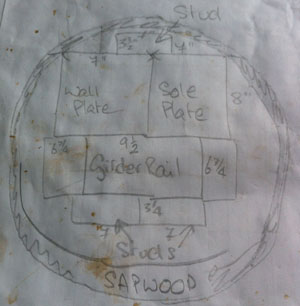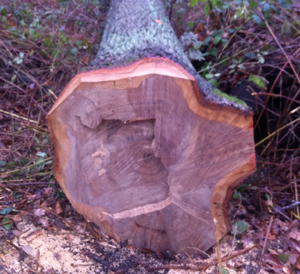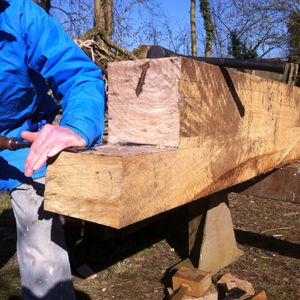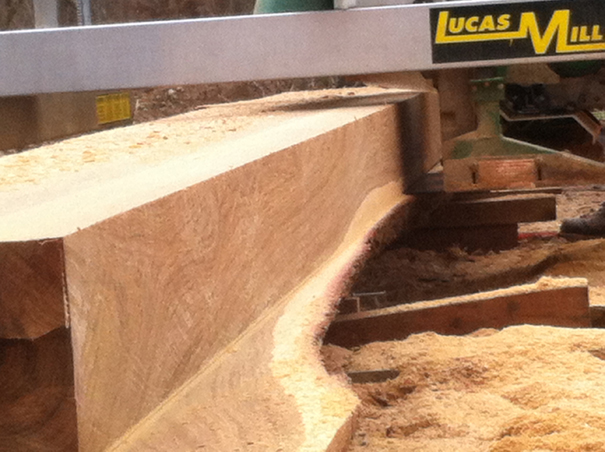
Cutting list (the theory!)

Buttress of oak tree (before milling)

Green oak jowl post (taking shape)
|
|
|
|
|
|
|
Through the Mill - 9th June 2018
Sourcing
Local Timber for a Tudor Long House
As some of you may know in addition to
the challenge of restoring a 17th century barn as a community run
project, I have also obtained permission to reinstate a Tudor Long
House. I can't believe how long the list of jobs is becoming. In
particular sourcing materials locally is an ongoing challenge; which
brings me to the topic of this article: How to make best use of the
local trees Orchard Barn Volunteers have just bartered their time for.
So...
Wish me luck.
I’ve got a date with the mobile sawyers this Thursday. As part of my
job as Centre Manager of OBee Community Interest
Company I get to draw up the cutting lists for our timber framing
project, and more crucially to work out how best to instruct the
sawyers to mill two big oak trees.
The Lucas
Mill - a mobile saw mill

I started this line of work in 2008 but it doesn’t get any easier. I
feel the weight of responsibility keenly sitting on my shoulders. The
Lucas Mill and the resulting milled oak is only as good as the
decisions I make and there are many things to weigh up when assessing
the trees.
So what do we need the timber for? Well … I’m overseeing the
reinstatement of a Tudor Long House in a
‘like for like’ manner. This means sourcing trees
from the local woods and framing it
using traditional techniques and
hand tools. Ideally we would be hand converting the trees where
they
grew using axes and two-handled saws, (and we do occasionally undertake
some of that). However I will be sixty this summer and would quite like
this project to be complete within the next five years – not fifty! The
use of a portable wood mill is the compromise I make and it’s a good
one.
Community
project supported by volunteers
Greenways
are a group of volunteers from Ipswich who operate the mill
for local projects such as OBee CIC (the one I run). That said, they
mostly mill small dimension trees whereas the ones OBee Volunteers have bartered their time
for are 130 years old, and are BIG. Measuring 18” at the buttress and
tapering off to 12” at 15’ they pose a challenge as to how to make best
use of them.
Top of my cutting list is a 12’ jowl post. The jowl post holds the wall
plate which in turn holds the roof up, so it is a key component of a
traditional timber frame. Many years back I had a light bulb moment
when I realised that a jowl post was essentially an upside down tree.
Our ancestors used the knarled buttress with all its knitted together
strength to support the upper part of the building. Makes sense! Why go
to the trouble of hewing it into a square section when you actually
need that volume of timber in a buttress shape. Having said that, it is
more effective to hew a jowl than mill it. Machines cut in straight
lines and are very wasteful whereas an axe makes much better use of a
tree with all its irregularities. (If
any of you are up for the challenge of
hewing please email me)
It’s these natural tree shapes and forms which I love so much that also
challenge me in a visual-spacial manner. I need to carefully assess the
trees for depth of sap wood, cracks, knots, rot and undulation (they
are rarely straight). Only after I have considered all of these factors
can I make an informed decision about how best to instruct the millers.
It’s going to
be an exciting date!
Sign up to the
Orchard Barn newsletter to hear how the day went.
|
|